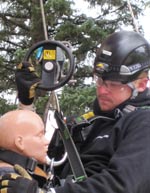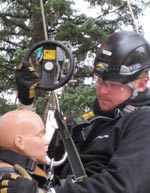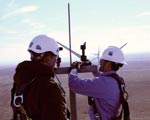
Training Wind Energy Workers
It is critical to include hands-on usage and practical evaluation of metering equipment to ensure employees can demonstrate competence in using such equipment for their own safety.

A typical wind training career program should includecompetent climber/tower rescue.
What is the big deal about constructing, operating, and servicing a wind turbine? Ask anyone who has been involved in this industry for more than 20 years, and he will describe a time that is different from today only in the breadth and scale of these renewable energy-generating machines. The sophistication of these systems has increased enough to require a concerted effort to formalize many of the safety protocols that have historically been just a part of the job.
The biggest difference from working on a gas turbine is that in the wind industry, the job is typically done high above the ground. This certainly adds anew level of safety protocols to the typical Job Safety Analysis. Twenty years ago, wind turbines were reaching 80 foot hub heights; today, the average technicianis working close to 300 feet above ground. These modern wonders are not only pushing the envelope on capturing the power in the wind, but they are shedding light on what it takes to work at heights to ensure the health and safety of everyone who works in and around this industry.
There are well-established safety regulations for employers and employees to follow while working around both low and high voltage (over 600 V), while working at heights up to 300 feet, and while working on and around rotating and pinching mechanical equipment. The challenge your average wind turbine technician faces is that he or she must do all of these tasks in sometimes extreme temperatures, in high winds, and under the pressures of task completion driven by deadlines and maintaining high availability.
Over the years, wind turbine-specific training programs have evolved. These programs started as internal corporate measures related to safety compliance and improving product reliability through a better-trained workforce. With the wind industry’s recent growth, the demand for independent training and education has grown. Some manufactures require that technicians receive training through original equipment manufacturers’ programs as a requirement of their product warranties.

By far the most critical aspect of any training program is the emphasis on safety, which must be part of the culture of employment.
In some other industries, industry giants realized what they really needed to meet customer demands were certified training partners who offered the same quality of service with much higher accessibility to the customer. Similarly, the advance toward independent training options within the wind industry brings considerations that should affect any potential student’s or employer’s decision on whom to hire and what type of training to seek.
By far the most critical aspect of any training program is the emphasis on safety. Safety is not an event that comes around periodically or when the tower rescue card is about to expire. Safety is personal. It must be part of the culture of employment to ensure it is a conscious, active part of the job.
Height Safety
In the wind industry, the first consideration typically is working at heights. OSHA requires all employees working at 4 to 6 feet or more above the ground to have 100 percent tie off using an approved Personal Fall Arrest System. There are various types of systems manufactured.
During the past few years, there has been increased emphasis on the training certification of all employees on the operation and use of height rescue equipment. This specialized safety equipment is specifically designed so anyone working above ground on a wind turbine has a means of self-rescue or has the equipment and training to rescue someone else within the tower.
Electrical Safety
Working around electricity at heights means all safety protocols must be followed by the trainee and ingrained in the culture.
Training programs should be based on NFPA 70E, National Electrical Code, and National Electrical Safety Code standards.The programs should prepare technicians to work around voltages up to 34.5kv. Courses should be designed to meet industry requirements, qualifying personnel to perform metering and breaker switching functions on voltages up to 1kv. In addition, it is critical that any training should include hands-on usage and practical evaluation of metering equipment to ensure students and/or employees can demonstrate their competence in using such equipment for their own safety, and for the protection and reliability of the equipment on which they will be working.
Career Programs Elements
A typical wind training career program should, at a minimum, include the following, not necessarily in this order;
1. Competent climber/tower rescue
2. OSHA 10 General Industry or Construction Safety (wind specific, if possible)
3. First aid/CPR & AED
4. Electrical and electrical metering safety
5. Metering equipment practical evaluations
6. Mechanical safety
7. Torque equipment and other tools of the trade
8. Crane signal and rigging practices
It is critical to note that the success of any training program is only as strong as the recordkeeping behind it. A good saying to remember in this context is, “If the training is not documented, it never happened.”
This article originally appeared in the April 2010 issue of Occupational Health & Safety.